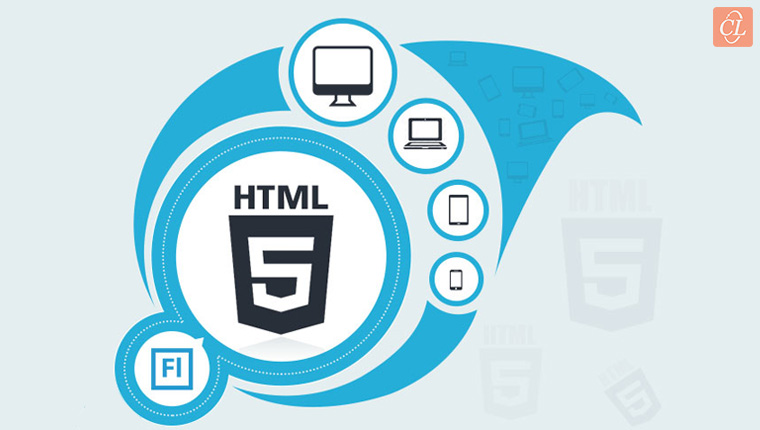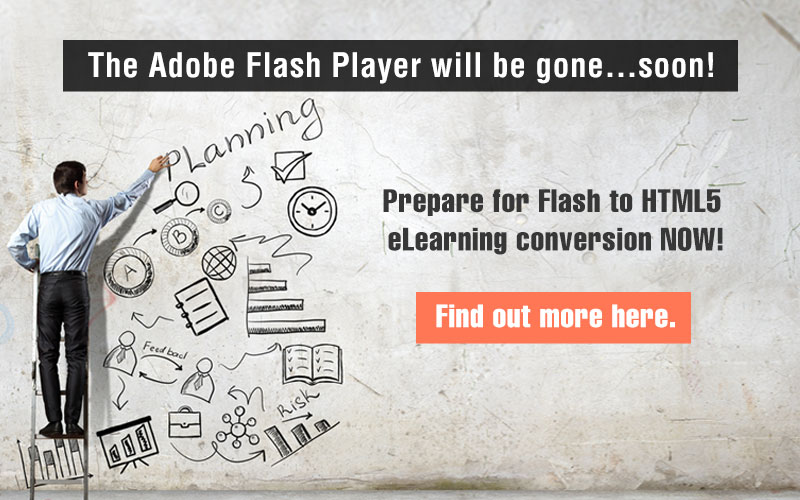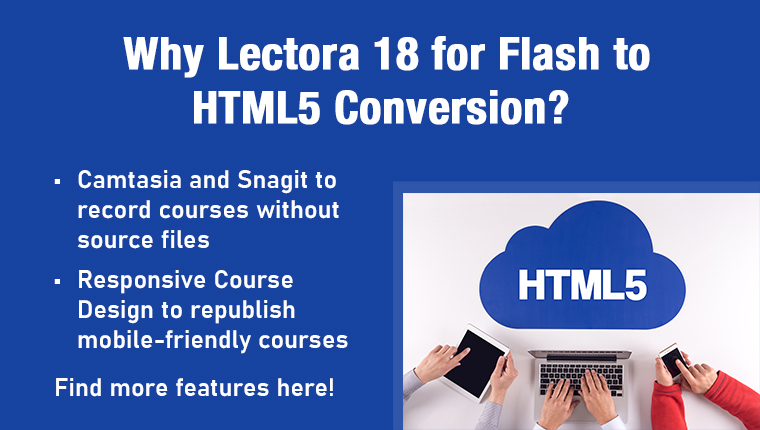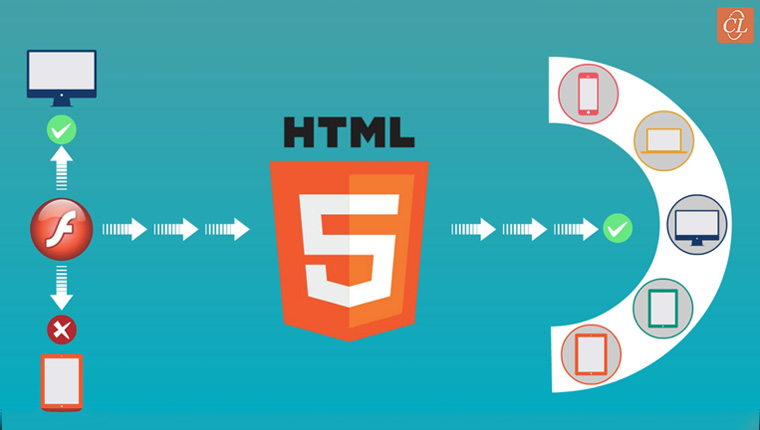Flash to HTML5 Conversion Services: Why, How, What, and When
Have questions on Flash to HTML5 conversion services? Check this blog to get answers to the why, how, what, and when of Flash to HTML5 conversion services.

There’s a lot of buzz currently around Flash to HTML5 conversion services. If you’re wondering why, it’s just one reason… Adobe has decided to pull the plug on a software that’s been a long-time favorite of eLearning developers. In 2017, Adobe along with Apple, Microsoft, Facebook, Mozilla, and Google announced that support for Flash will be ramped down over the next 3 years. What does this imply for your organization?
It means online training programs developed in Flash will stop working and Flash components used in e-learning courses will no longer play. That essentially means you’ll have to get your Flash-based eLearning converted to HTML5 (Flash courses that are still relevant to your training needs), if you haven’t done so already.
6 FAQs on Flash to HTML5 Conversion Services Answered
- What is the need for Flash to HTML5 conversion services?
- How to identify if your existing eLearning courses use Flash?
- How have authoring tools overcome the limitations of Flash?
- How to decide between insourcing and outsourcing Flash to HTML5 conversion services?
- What are the types of Flash to HTML5 conversion services available?
- When to use each Flash to HTML5 conversion service?
Questions on Flash to HTML5 Conversion Services
Let’s get down to the nitty-gritties of answering a couple of questions you might have on Flash to HTML5 conversion services.
1. What is the Need for Flash to HTML5 Conversion Services?
Flash-based eLearning will stop working, and that’s reason enough to opt for conversion to HTML5. But what led to this decision of phasing out Flash? Here are some reasons.
Flash was never supported by iOS devices, including the iPhone and iPad. So organizations looking at eLearning courses to be made accessible on iPads or iPhones can’t do so if online courses use Flash components.
Web browsers will stop supporting the Flash player by 2020. So Flash-based courses are simply going to become inaccessible to learners. Makers of web browsers have detailed roadmaps in place to phase out Flash.
Apart from draining the battery life of mobile devices, Flash is a favorite target of hackers. By opting for Flash to HTML5 conversion services, you can overcome the security vulnerabilities posed by Flash.
With most organizations looking at training solutions that can be implemented quickly, rapid eLearning development has become the order of the day. HTML5-based authoring tools are more suitable to meet this requirement because of the templates that they offer.
Organizations that prefer implementing mobile learning solutions look for responsive eLearning that’s accessible seamlessly on multiple mobile devices. While HTML5 supports responsive design, Flash has never supported it.
If you’ve ever wanted to translate your Flash-based courses, modernize the instructional design or even migrate to a new LMS, now is the time to do so. Apart from quickly converting your source course from Flash to HTML5, you can also get it translated into various languages (most good eLearning service providers offer this option) as HTML5-based authoring tools ease the process of integrating translated text.
2. How to Identify if Your Existing Courses Use Flash?
Before going in for Flash to HTML5 conversion services, examine the files in your existing e-learning courses. If any of them have the extension of .swf or .flv, it means they use Flash components and can only be viewed on a browser that supports the Flash player. These Flash components could be interactivities, animations, graphics or assessments.
3. How Have Authoring Tools Overcome the Limitations of Flash?
When you opt for Flash to HTML5 conversion services, it’s essential to pick an authoring tool that meets your conversion requirements. As mentioned earlier, HTML5-based authoring tools offer a lot of advantages compared to Flash. Here’s how authoring tools score over Flash:
eLearning courses developed using HTML5-based authoring tools are supported by various mobile devices and across various platforms, including Android and iOS.
Authoring tools are easy to use and do not require programming knowledge. They also offer a range of interactivities and media elements that can be used to design interesting custom e-learning courses.
Rapid e-learning is a breeze with the in-built templates offered by authoring tools.
Since a specialized skillset of resources is no longer necessary as in the case of Flash (requires the knowledge of ActionScript programming), the cost of e-learning development is brought down considerably.
Collaborative authoring and review of eLearning courses is a reality, thanks to cloud-based authoring tools.
4. How to Decide Between Insourcing and Outsourcing Flash to HTML5 Conversion Services?
Now that you understand how to identify Flash-based eLearning courses and are aware of how authoring tools ease the conversion process, we come to the important question of whether to seek Flash to HTML5 conversion services in-house or outsource it to an eLearning vendor.
To help you take better decisions, here are the pros and cons of insourcing vs. outsourcing of Flash to HTML5 conversion services.
Pros and Cons of Insourcing Flash to HTML5 Conversion Services
|
Pros |
Cons |
|
|
Pros and Cons of Outsourcing Flash to HTML5 Conversion Services
|
Pros |
Cons |
|
|
Comparing the pros and cons of insourcing and outsourcing Flash to HTML5 conversion services, it’s evident that outsourcing is a better decision, especially when you’re under time and budget constraints.
5. What are the Types of Flash to HTML5 Conversion Services Available?
When you opt for a Flash to HTML5 conversion service, working in tandem with a qualified eLearning vendor, you get to choose from the following four conversion strategies – called the 4 ‘R’s.

Record – A basic level of conversion where old Flash courses are recorded in the MP4 format and the course does not require interactive elements
Republish – Courses developed in an older version of an authoring tool are republished in the latest version of the authoring tool to deliver HTML5 output
Rebuild – Relevant media elements are retained, and courses are rebuilt in the latest version of authoring tools so that they can be seamlessly accessed over multiple devices and platforms
Redesign – A new authoring tool is used, and the course is completely redesigned – it could mean new media, instructional design strategy, or even updated content
6. When to Use Each Flash to HTML5 Conversion Service?
Understanding which conversion strategy or service suits your requirement(s) will help you gain an understanding of the investment required to convert Flash or other legacy courses to HTML5-based courses. It can also help you decide if the conversion process can be handled in-house or requires outsourcing to an eLearning partner.
Here’s a table that can give you pointers to narrow in on the conversion strategy when you opt for a Flash to HTML5 conversion service.
|
Conversion Strategy |
When to Use? |
|
Record |
|
|
Republish |
|
|
Rebuild |
|
|
Redesign |
|
It’s a Wrap
With a range of conversion strategies at hand, you can transform your existing training repository of Flash-based eLearning to deliver HTML5 courses that can be accessed seamlessly on mobile devices by learners, while retaining high engagement levels.
If you have quite a lot of Flash-based courses to convert, it can seem overwhelming, but with a little bit of planning, you should be able to leverage Flash to HTML5 conversion services to its fullest potential – be it in-house or through an external vendor or eLearning partner.
Before you opt for Flash to HTML5 conversion services, going through our eBook ‘Flash to HTML5 eLearning Conversion – The 4 ‘R’s That Matter’ can help you get started with a smooth transition plan for HTML5 conversion.





